At elite levels of piano playing, very subtle things will distinguish winners from everyone else – just as in many sports. The more technical barriers a pianist has to overcome, the greater the disadvantage in relation to others with the same ability but without those barriers, of which hand size is clearly one. Other physical factors that could negatively affect a performance, such as stool height, have long been recognised by pianists and dealt with by providing choice.
Piano performance can be compared with those sports that require a blend of artistic and technical skills (such as many winter sports). The quality of equipment and clothing and their suitability for the specific needs of the performer can make a difference at the highest levels of competition. Any skier in an international competition would be disadvantaged if his/her skis were too short or too long for the particular event. For elite pianists, competition for performing careers is intense and a high level of technical skill and musicality is taken for granted. A pianist who is able to perform on an instrument most suited to their hand size is likely to perform the advanced repertoire better and with greater security.
Many concert pianists launch their careers on the basis of their success in high level piano competitions. While smaller-handed pianists can choose repertoire to suit their hand size, those who sustain a successful performing career (including those who perform in ensembles) are normally expected to play a wide range of repertoire.
Gender differences in major competitions and performing careers
While adult males are usually outnumbered by women in tertiary institutions and among piano teachers, they dominate the lists of prize winners in major international piano competitions and the ranks of professional pianists.
Major performing and recording artists over the last 100 years have overwhelmingly been male. Many of the best known female artists have focused mainly on baroque and early classical repertoire.The same pattern of gender difference is not apparent when one looks at violin competition results. The violin is an instrument for which different sizes and variations in design are available with resulting less evidence of disadvantage relating to hand span.. Children normally have the benefit of starting to play the violin on a smaller version.
Note the make-up of students at the prestigious Seiji Ozawa Academy in Lausanne, Switzerland. The Academy selects from among the best young string players around the world and prepares them for playing at the highest level in string quartets. There is a very even split between men and women (including those of Asian background) among the students. http://www.ozawa-academy.ch/index.php/en/academy/
Van Cliburn semi-finalists 2017 –>

International piano competitions - gender and ethnic differences
Christopher Donison (1998) has commented on the relatively small proportion of female piano competition winners at a senior level, given that they generally greatly outnumber male students in universities. Reviewing the prize-winners in several international piano competitions over the last half century, men do indeed outnumber women among the prize-winners with two exceptions. For most of these competitions, the percentage of female prize-winners, taken over all competition years together, ranges between 14% and 25%. In the International Chopin competition, women have been more successful, making up 36% of prize-winners. However, looking at first prize winners in each of these competitions, the proportion of women shrinks further in many cases. There is no sign of any improvement in the gender imbalance in more recent years.
The two exceptions where women outnumber men among prize winners are the International Bach competition and the International Mozart Competition (age categories of 17 and above). This suggests that when playing Bach or Mozart, men and women may be much more on a level playing field. See Table 1.
Considering ethnic background of female first prize winners, a high proportion are from from Russia or former USSR countries, with very few of Asian descent. A scan of international violin competition results shows a different picture. Female and male prize-winners are comparable in number and Asian women are strongly represented.
The International Tchaikovsky competition, held every four years, features both piano and violin competitions. Only one woman has ever won the top prize (first, or second where first was not awarded) in the piano section. However, eight women have won the violin section, seven of these since the 1980s.
These results support the contention that relatively large hand spans are needed for pianists to compete at an elite level across a wide range of repertoire – and hence, launch a performing career.
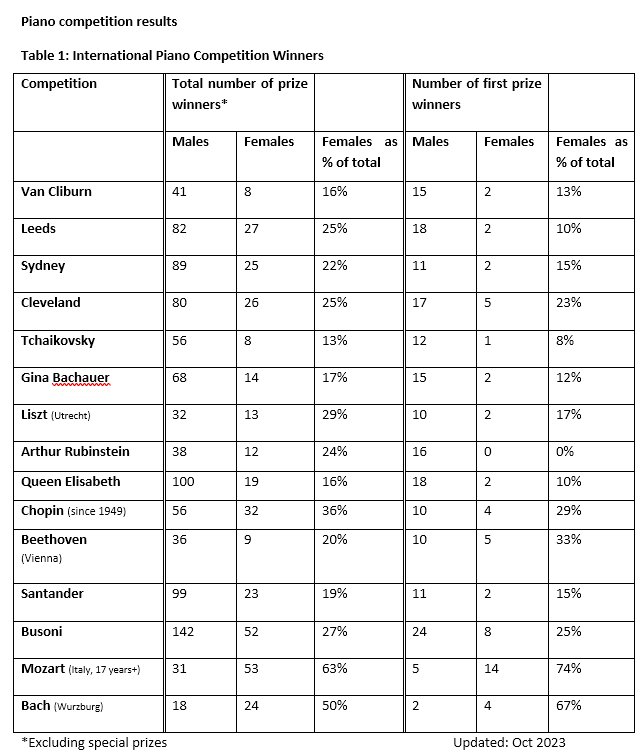
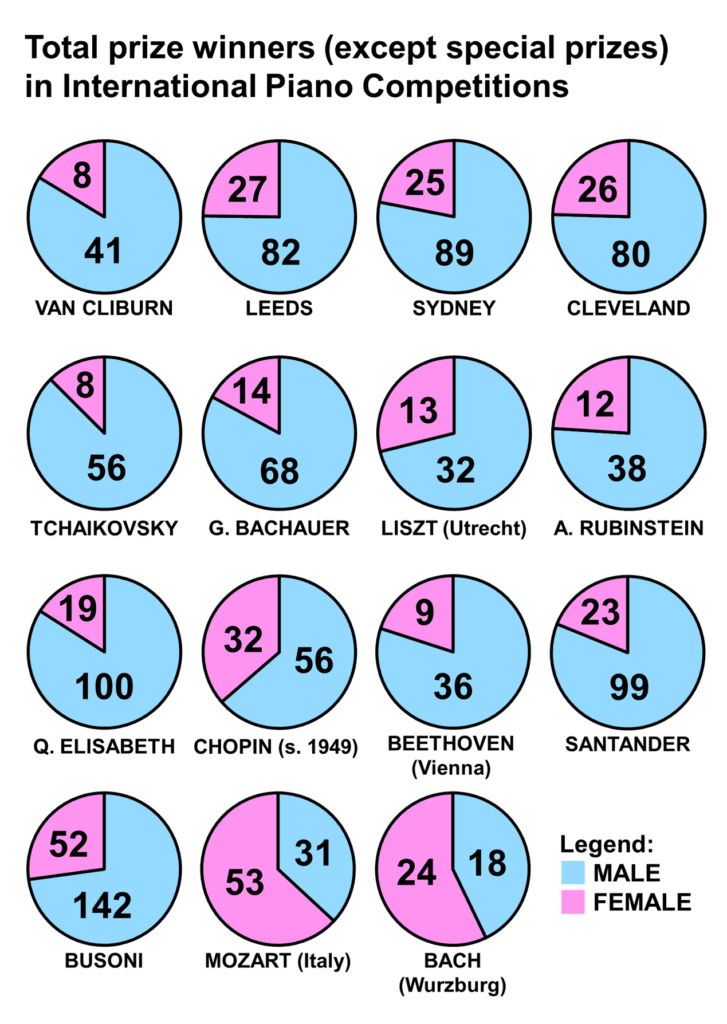
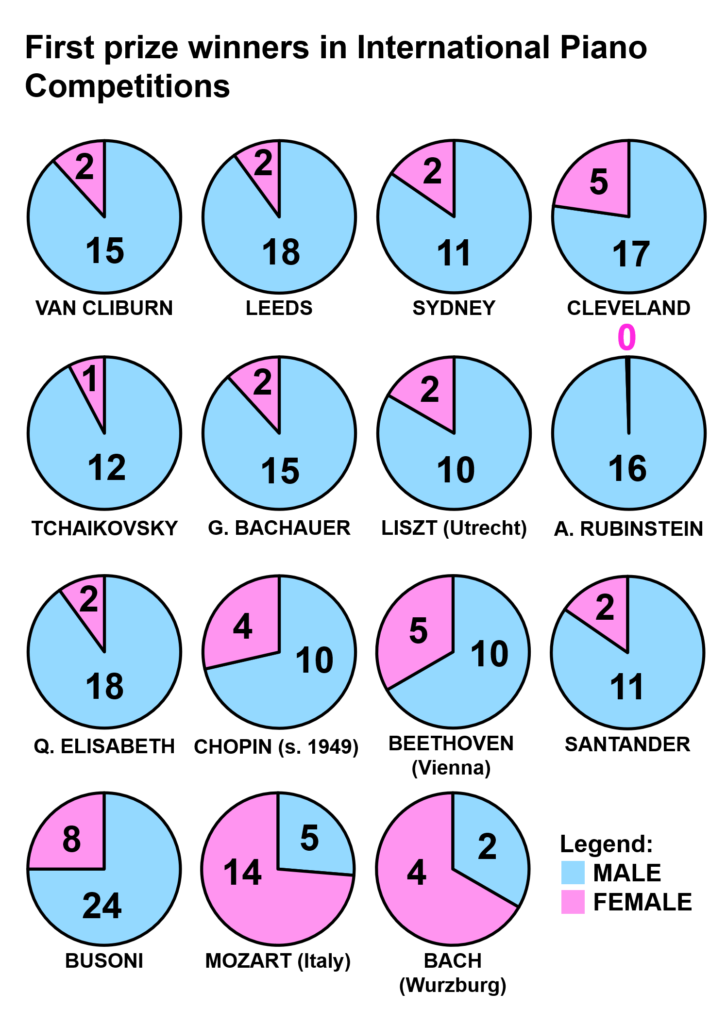
Above charts prepared for PASK by Valky River
It is reasonable to assume that the gender balance might have improved over time. But looking at the percentage of females among all prize winners during each decade back to the 1960s, there is no improvement at all!
And for every decade since the 1960s, the proportion of females winning first prize is even less – ranging from 11% in the 1980s to 22% in the 1970s.
(Data from all of the above competitions included apart from Bach and Mozart.)
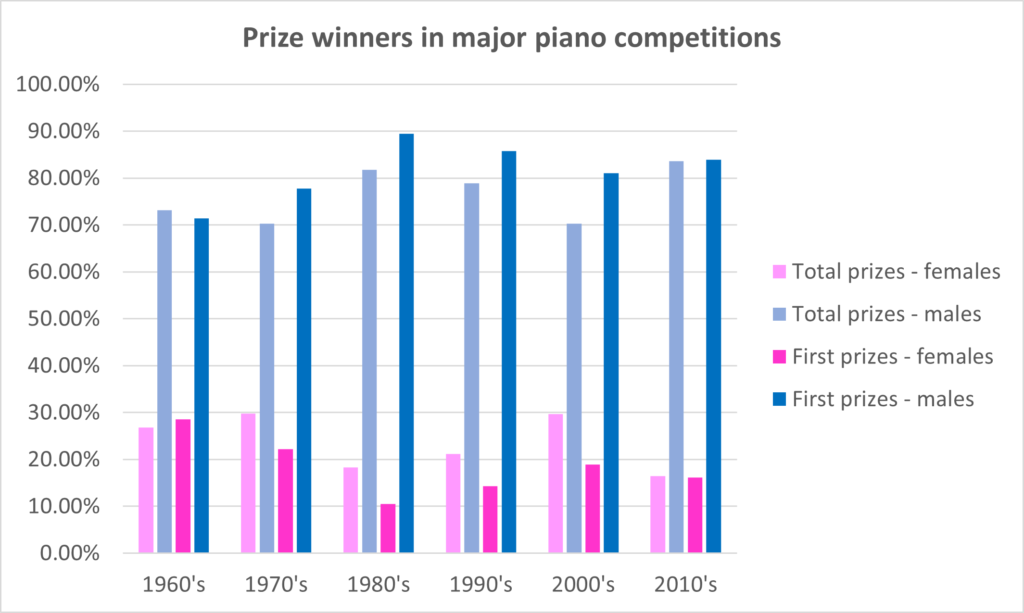
MTNA NATIONAL COMPETITION RESULTS
The national US music competitions run by the MTNA (Music Teachers National Association) are held annually and include four age categories: Junior (11-14 years), Senior (15-18 years) and Young Artist (19-26 years). Reviewing results since 1963 (refer Table 2), females outnumber males among first prize winners in the junior category, males slightly outnumber females in the senior category and even more decisively (double) in the ‘young artist’ category. But when looking at the results of the MTNA strings competition, there is no similar drop-off of female prize winners with age – females outnumber males in all age groups, though only slightly in the ‘junior’ category. The charts below illustrate very clearly.
UK EPTA national piano competition results provide another example of how males increasingly dominate piano competition prize winner lists as one moves up from junior to elite levels.
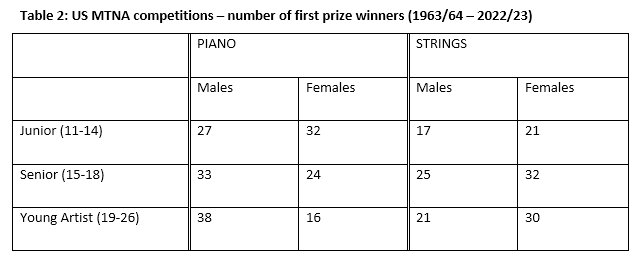
MTNA winners: 1963/64 to 2023/24


Recording artists of the 20th century
The Philips recording company has released a set of CDs featuring what it considered the greatest pianists of the 20th century. There are 73 pianists featured, 11 of whom are female. Two of these (Brok and Lheviine) are part of two-piano partnerships, and the majority of the remaining nine are best known for Baroque or Classical repertoire. The female pianists featured were:
Martha Argerich
Lyubov Brok
Ingrid Haebler
Clara Haskil
Dame Myra Hess
Alicia de Larrocha
Rosina Lhevinne
Maria Joao Pires
Rosalyn Tureck
Mitsuko Uchida
Maria Yudina
These observations lend support to the contention that their smaller hand size prevents many women from achieving their full potential in piano playing at elite levels – particularly in the performance of Romantic and 20th century repertoire. In those elite competitions where a wide range of repertoire must be presented, plus those focusing on specific Romantic composers, the proportion of male to female prize winners is approximately three or four to one. Given that the proportion of males to females who have hand spans large enough to accommodate a 10th is nearly six to one, females are doing remarkably well, perhaps reflecting the greater numbers who proceed to tertiary level piano performance studies.
It is often mentioned that the famous Spanish pianist, Alicia de Larrocha, had small hands. Although small in stature (140 cm, or 4 feet 7 inches), she had relatively large hands for a woman, being able to reach a 10th in her heyday. (Interview with New York Times, published 23 November 1995.). A recent study by Boyle, Boyle & Booker presented to the 2015 Australian Piano Pedagogy Conference: http://www.appca.com.au/proceedings/ looked at the relationship between height and hand span among a group of university students. The analysis found height to be a relatively weak predictor of hand span. In other words, there are short people who have relatively large spans and tall people who have relatively small spans. See: Hand span versus height
References
Booker, E., & Boyle, R. (2011). Piano keyboards – one size does not fit all! Pianistic health for the next generation. Proceedings of the 10th Australasian Piano Pedagogy Conference: Leading Notes to Effective Teaching: Resolving the past – Exploring the future. Charles Sturt University, Wagga Wagga, 4-8 July 2011. http://www.appca.com.au/proceedings/
Boyle, R., Boyle, R. & Booker, E. (2015). Pianist Hand Spans: Gender and Ethnic Differences and Implications for Piano Playing, Proceedings of the 12th Australasian Piano Pedagogy Conference, Beyond the Black and White, Melbourne, July 2015. http://www.appca.com.au/proceedings/
Boyle, R. (2024). The real reason men dominate major piano competitions. https://paskpiano.org/wp-content/uploads/2024/09/The-real-reason-men-dominate-major-piano-competitions-_-Gramophone.pdf
Donison, C. (1998). Small hands? Try this keyboard, you’ll like it. Piano & Keyboard, July-August, 41-43.
http://www.nytimes.com/1995/11/23/garden/at-home-with-alicia-de-larrocha-a-pianissimo-star.html


